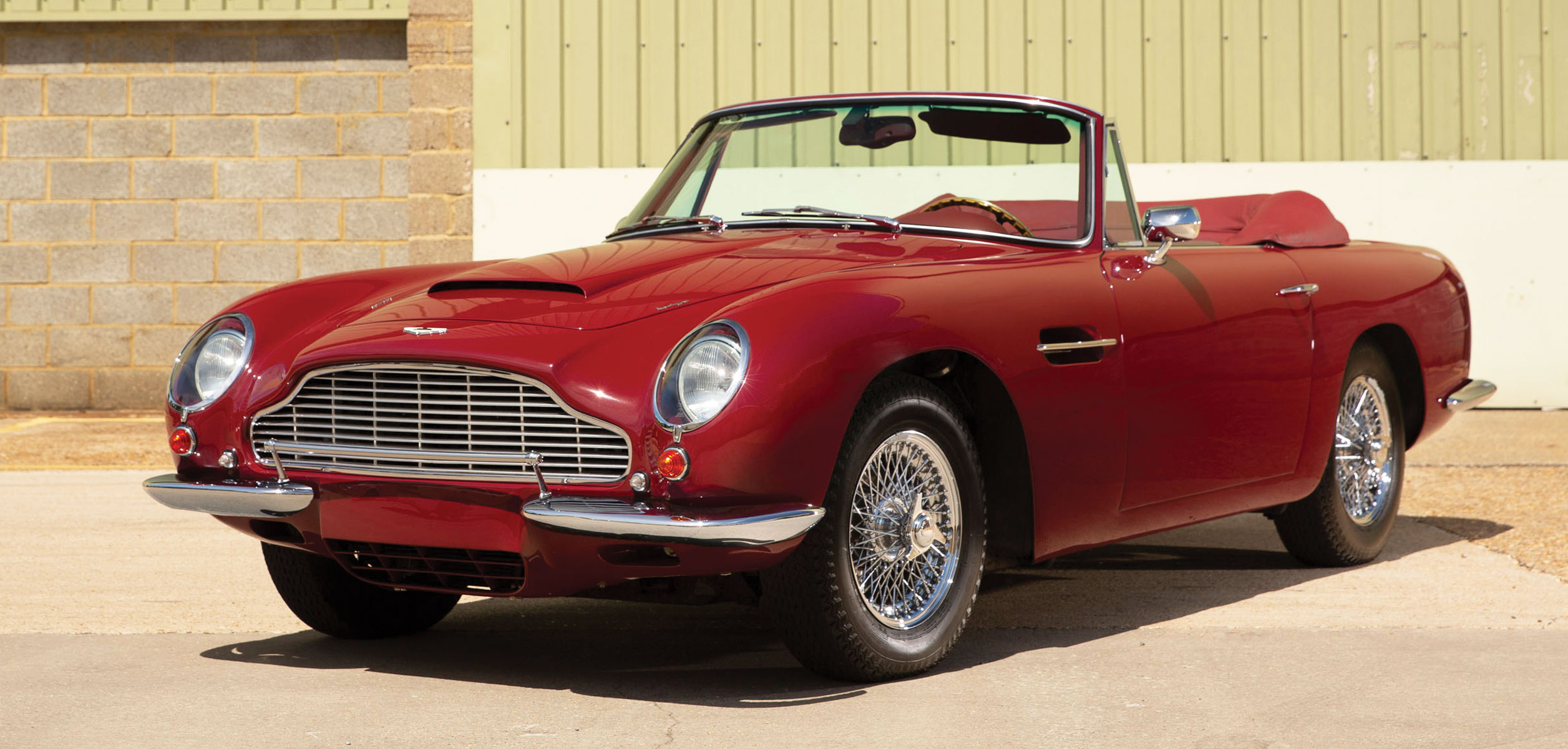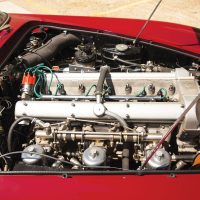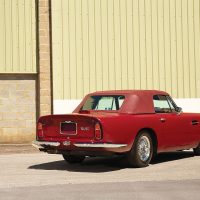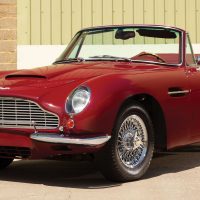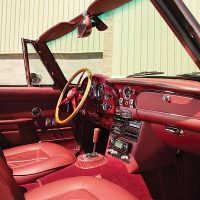SCM Analysis
Detailing
| Vehicle: | 1967 Aston Martin DB6 Volante |
| Years Produced: | 1966–71 |
| Number Produced: | 140 (long-chassis cars) |
| Original List Price: | $13,995 |
| SCM Valuation: | $625,000 |
| Tune Up Cost: | $500 |
| Distributor Caps: | $81 |
| Chassis Number Location: | Plate on right side of scuttle |
| Engine Number Location: | On left of cylinder block next to alternator |
| Club Info: | Aston Martin Owners Club, Drayton St. Leonard, Oxfordshire OX10 7BG +44 1865 400400 |
| Website: | http://www.amoc.org |
| Alternatives: | 1964–65 Aston Martin DB5 Vantage, 1964–67 Jaguar E-type Series I 4.2, 1965–66 Ferrari 365 GTC |
| Investment Grade: | B |
This car, Lot 408, sold for €627,000 ($711,520/
£562,200), including buyer’s premium, during RM Sotheby’s Online Only: The European Sale Featuring the Petitjean Collection on June 11 2020.
Our subject car, DBVC3623LC (on the chassis plate: the chassis is stamped DBVC3623L), has a fascinating early history.
One of 140 DB6-based Volantes following the 37 interim cars built on the shorter DB5 chassis, it was one of two of its type delivered new to Mr. and Mrs. John “Jack” Dorrance Jr. Dorrance’s father, also John, had invented condensed soup and headed up the Campbell Soup Company from 1914 to 1930. Later, Jack himself was chairman of the company from 1962 to 1984. Delivered alongside chassis number 3644 in August 1967 through Aston Martin’s distributorship in King of Prussia, PA, this car is thought to have been finished in triple black when new and fitted with factory air conditioning, while 3644 was said to have been finished in triple white.
English Aston Martin collector Anthony Moody bought the car in the 1990s from a classic-car dealer in Philadelphia and shipped it to Import Classics of Marietta, GA, where its automatic gearbox was replaced with a ZF 5-speed. Then the car was refinished black.
That done, Moody shipped the car to the U.K., where Aston specialist RS Williams was commissioned to perform a complete mechanical overhaul, including a 4.2-liter overbore, which appears almost mandatory these days — though one often wonders why, as it adds only 5% to the capacity so the difference must be negligible (says the owner of a 2-liter Escort bored to 2094…).
Moody used the finished car on a number of vintage rallies, including the Rally du Maroc in 2003, Rallye de Slovenie, and the Rallye des Alpes.
Back to an automatic
The last owner bought the car from Moody through RS Williams in 2004 and three years later commissioned a restoration with Aston Martin Works — which is never going to be cheap — adding a number of upgrades: a modern 4-speed automatic transmission, power steering (only the Mk2 had it as standard), modern a/c and satellite navigation. The car was repainted Dubonnet Red over an Oxblood interior.
The suspension now wears Koni adjustable dampers. It has done less than 800 km since the restoration and still presents well, except where the front valance had been crunched into a curb or similar. That’ll be a few hundred dollars to straighten and repaint. Luckily, the damage is in an area where it won’t be noticed too much, in case the paint’s not a perfect match.
It looks like a DB5, but it’s different
First appearing as a convertible at the 1966 London Motor Show, DB6s are built differently than the DB5, although they look superficially similar.
The DB5 car shares the Superleggera (super-lightweight) construction of the DB4, which wraps aluminum paneling around a tubular steel frame welded to a steel platform chassis.
The DB6, four inches longer in the wheelbase, uses a folded-sheet-steel inner structure (although it still wears Superleggera badges), but surprisingly, it’s claimed to weigh only 17 pounds more than the DB5 and is only two inches longer overall.
A complete DB5 or DB6 restoration at Aston Martin Works is in the region of £500k/$600k, although we don’t know exactly how much work this car had.
Sorting through the numbers
After those first 37 DB5-based cars known simply as Short-Chassis Volantes, just 140 DB6-based Volantes were built, including 29 325-bhp Vantage versions.
Our subject car is one of the regular 282-bhp versions.
Numbers appear rather confusing. The 140 figure (longtime Aston dealer Byron International says 148) is variously applied to all DB6 Volantes, or sometimes just the Mk1s. But given that there were only 240 Mk IIs (DB6Mk24101R–4345R), added to a total production of 1,327 Mk1s, few can have been ragtops.
Britain’s very own King-in-waiting Prince Charles owns one, famously given as a 21st birthday present by his mother and lately converted to run on bioethanol — reconstituted surplus wine — from his Duchy of Cornwall estate.
Originally, the convertible cost the same £4,998 as the coupe, and the customer could specify a Powr-Lok limited-slip differential, chrome wire wheels and an automatic gearbox at no extra cost. An electric aerial was fitted as standard, although the radio, which would be a customer choice, was considered an extra and was charged accordingly.
Swapping parts is the new normal
Upgrades with modern parts are popular on old Astons and to a lesser extent, Jags, because, frankly, in their original form they’re too much like hard work for some owners to cope with.
If you’ve only operated modern motors, the physicality of a 50-year-old sports car can be a bit of a surprise — as Publisher Martin has been discovering with his detuned left leg.
Although the DB6 Mk1 had the option of power steering, this one evidently didn’t, but it’s relatively easy and cheap to add electric assistance, whose heft can be turned up and down at will, as here.
I’m not a fan of automatic transmissions, and if you’ve driven one of the 3-speed BorgWarners of the type the DB6 was originally lumbered with, you’d see why.
A modern, responsive auto brings the car into a different age and, nicely, this conversion uses the original-style gear selector so the interior still appears stock — apart from the modern Blaupunkt stereo and the steering-wheel spokes rather fussily painted in body color.
Factory a/c would have meant that to make room for the receiver/evaporator behind the rear seat, the single main fuel tank would have been ditched, replaced by twin tanks in the rear wings, which this car still has. It’s also got 123 electronic ignition, which should make the need for tune-ups less frequent, a high-level brake light mounted on the trunk lid, and a modern alternator to run it all.
As we observed last month, in the current market it’s correctly priced.
Discreet-(ish) modifications of this type don’t generally affect values much either way, the degradation of originality no doubt canceled out by enhanced user-friendliness. However, it looks as though the last owner has invested (and lost) a bundle shelling out for the restoration and upgrade works, so for that we probably ought to kick this one up into the “well bought” column.
One anomaly of the online auctioning system is that the cars no longer have to be tied to wherever the bidding is taking place. Although this “European” sale was nominally located in Essen, Germany, with transactions in euros, the car needed collecting from Surrey, England, home of RS Williams, although it did not have its taxes paid in the U.K.
Finally, perhaps, the collector-car auction market has truly gone global. ♦
(Introductory description courtesy of RM Sotheby’s.)
